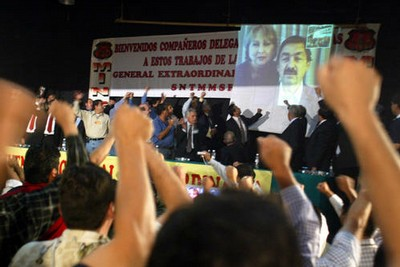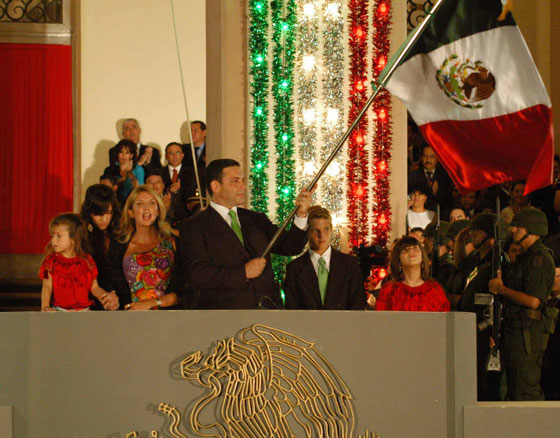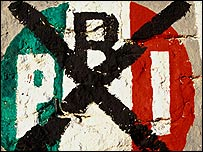La televisión mexicana y la transformación del poder en México en el siglo XXI
por: Javier Esteinou Madrid / Universidad Autónoma Metropolitana, Unidad Xochimilco
(for English, click here)

Napoleón Gómez Urrutia
Con la introducción de las tecnologías electrónicas de información de masas en México, con la radio en 1920 y la televisión en 1950, el poder ideológico de las industrias culturales paulatinamente desbordó la esfera de control y de orientación del Estado tradicional. De esta manera, éste moderno poder entró en una nueva fase de desarrollo vertiginoso que rápidamente rebasó los límites de los controles políticos y jurídicos convencionales creados por el Estado mexicano y se fue conformando paralelamente como un poder ideológico independiente que se enfrentó a los otros tres poderes republicanos formales que constituyen al Estado nacional (Poder Ejecutivo, Poder Legislativo y Poder Judicial), e incluso en algunos casos los reformuló y en otros los substituyó.
A partir de este momento histórico que se constató que si a mediados del siglo XX el Estado mexicano estaba constituido por 3 poderes formales como fueron el Poder Ejecutivo, el Poder Legislativo y el Poder Judicial; a principios del siglo XXI, en términos reales, el Estado mexicano ya está compuesto por 4 poderes: 3 poderes formales tradicionales que son el Poder Ejecutivo, el Poder Legislativo y el Poder Judicial; y un reciente poder fáctico, que es el nuevo Poder Mediático. Este último poder, cada vez más, silenciosamente frente a nuestras narices, se convirtió en el Poder del Poder que progresivamente subordinó y presionó al resto de los 3 poderes constitucionales formales de nuestro Estado-Nación para someterlos a su voluntad mediático empresarial e imponer su proyecto de construcción de sociedad, de economía y de seres humanos.
En éste sentido, si la lucha por nuestra independencia nos dio la edificación de la Primera República, la realización de la reforma Juarista aportó la cimentación de la Segunda República y la Revolución Mexicana colocó los fundamentos de la Tercera República en el país[i]; con la consolidación del nuevo poder mediático, especialmente de 1960 en adelante, se conformó lentamente en nuestro país la Cuarta República que dio origen a la nueva República Mediática en el siglo XXI con su respectiva mutación estatal y social. Dicha entidad poco a poco, creó culturalmente un país opuesto al de los anteriores espíritus constitucionales de nuestra historia nacional e incorporó una mentalidad únidimensional de la vida funcional para el proyecto de super acumulación económica.

Eugenio Hernández Flores
De ésta manera, sí en el terreno comunicativo la sociedad mexicana pasó de la declaración del espíritu de los Sentimientos de la Nación de 1800, que buscaban fundar la nueva República Federal para darnos un nuevo orden civilizatorio superior a nivel nacional, con el reconocimiento de los nuevos derechos civiles y creación de modernas instituciones públicas; en la etapa del 2000 se pasó a la declaración de la pragmaticidad de los sentimientos del mercado autorregulado, regidos por la Mano Invisible de la ley de la libre oferta y demanda informativa, que lo que pretenden es la consolidación del modelo de mercado como regla básica para vivir, relacionarnos, comunicarnos y ver la vida en comunidad.
En éste sentido, las primeras 3 Repúblicas Nacionales se gestaron por necesidades históricas consensuadas de la mayoría nacional para darle forma estructural equilibrada al proceso de gobernabilidad social en México y de maduración de diversos procesos históricos colectivos de participación socio política que buscaron la creación de contrapesos a los poderes públicos para gobernar armónicamente en el país. En cambio, la 4a República Mediática emergió por la introducción de la fuerte revolución tecnológica en el terreno comunicacional del país, por la formación de los monopolios de la comunicación electrónica, por la concentración de grandes cuotas de poder de las industrias culturales a nivel comunicativo, por la incapacidad del Estado mexicano de poner bajo un orden jurídico justo a los poderes mediáticos salvajes, y finalmente, por la necesidad unilateral de la ampliación de los requerimientos del mercado, a escala ampliada, en la esfera ideológica de nuestra sociedad.
De esta forma, a diferencia de la construcción de las otras 3 Repúblicas anteriores que significó un avance democrático para darle forma y organización al funcionamiento colectivo de la sociedad mexicana, bajo la estructura de tres poderes federales diferenciados, autónomos y complementarios; la creación de la 4a República Mediática no es un avance democrático, sino que es la fuerte imposición de un nuevo poder fáctico y “autorregulado”, e incluso salvaje, que compite en el campo de acción y de influencia de los otros 3 poderes públicos establecidos constitucionalmente. Es decir, es un nuevo macro poder ideológico-político independiente que interviene significativa y crecientemente en la dinámica por la disputa de la estructuración, la conducción, el reparto y la explotación de la nación.
En éste sentido, mientras que durante el siglo XX el Estado mexicano cuidó celosamente que las redes de su poder tradicional no se debilitaran a través de la corporativización de las centrales obreras, la seducción de los intelectuales disidentes, el control de los brotes de insurrección campesina, la manipulación de las movilizaciones populares, la canalización de las protestas estudiantiles, la coptación de los descontentos burocráticos, incluso, la represión de los movimientos populares, etc; paradójicamente no pudo ver que el verdadero poder real que se construía y consolidaba abiertamente frente a sus narices ya no residía en las viejas dinámicas de los movimientos sociales de oposición, sino que se gestaba alrededor del avance de la revolución tecnológica que introdujo la presencia del modelo comercial privado de la radio y la televisión en nuestro país. Así, paralelamente al tejido de poder corporativo que construyó durante más de 70 años el Partido Revolucionario Institucional (PRI) para gobernar a la sociedad mexicana, se cimentaron y desarrollaron las bases del Primer Gran Poder Ideológico en la historia del México moderno, que escribió la otra historia mental y política de nuestra sociedad: El Poder Mediático.

PRI tachado en graffiti
Con la emergencia de la 4a Republica Mediática en México a través de la incorporación de los medios electrónicos de difusión colectivos en la estructura de conformación básica del Estado mexicano, éste se transformó sustancialmente para adquirir paulatinamente los rasgos de un Estado mediático que es el que opera cotidianamente en la fase de la modernidad nacional. Así, el ejercicio ideológico político del poder cotidiano quedó mediado por la acción concreta del Estado mediático desde mediados del siglo XX en México.
Por todo lo anterior a principios del siglo XXI el poder de los medios dejó de ser una variable de presión aislada e importante sobre el Estado Mexicano y de reconducción anímica de la sociedad en general, para convertirse ahora en un poder fáctico que forma parte de la columna vertebral del poder para estructurar ideológica y políticamente de forma cotidiana a la sociedad mexicana, especialmente en las grandes ciudades. Dentro de ésta perspectiva, entramos en la fase histórica de vivir bajo el imperio del nuevo poder informal de los medios de difusión colectivos, donde su fuerza fáctica compite permanentemente con el desempeño y las funciones de los otros 3 poderes constitucionales del Estado mexicano , hasta llegar, en ocasiones, al grado de minimizarlos, subordinarlos o disputar con ellos su centralidad y rectoría, para imponer a la colectividad su proyecto de desarrollo social y de vida que fijan las exigencias del mercado desregulado.
Nota
Martínez Álvarez, Jesús Emilio, Discurso de Posicionamiento del Partido Verde Ecologista de México (PVEM), IV Informe de Gobierno del Presidente Vicente Fox Quesada, Primer Periodo de Sesiones del Segundo Año de Ejercicio de la LIX Legislatura, Palacio Legislativo, México, D.F, 1 de septiembre del 2004, versión estenográfica, páginas 5 y 6.
Imágenes
Imágen cortesía de autor.
3. PRI tachado en graffiti
Javier Esteinou Madrid es Investigador Titular del Departamento de Educación y Comunicación de la Universidad Autónoma Metropolitana, Unidad Xochimilco, México, D.F.
Favor de comentar.
Por favor comente.
by: Javier Esteinou Madrid / Universidad Autónoma Metropolitana, Unidad Xochimilco
When electronic mass information technologies were introduced in Mexico, including radio in 1920 and television in 1950, the ideological power of cultural industries slowly overcame the sphere of control and orientation of the traditional state. Thus, this modern power entered a new period of frenzied growth which quickly overcame the limits of the conventional political and judicial controls created by the Mexican state; it thus developed in a parallel fashion as an independent ideological power that faced the three formal republican powers, the powers that embody the national State (Executive Power, Legislative Power, and the Judicial Power). In some cases, it even reformulated or substituted these powers.
In this historical moment, one can recognize that in the midst of the 20th century, the Mexican State was constituted by 3 formal powers: the Executive Power, the Legislative Power, and the Judicial Power. At the beginning of the 21st century, however, one recognizes that in real terms, the Mexican state is constituted by 4 powers: 3 formal and traditional powers, the Executive Power, the Legislative Power, the Judicial Power, and another, recent factual power, the new Media Power[a]. This last power, with increasing frequency, both silently and before our very eyes, became the Power of Powers, a force which progressively subordinated and pressured the other three constitutional powers of our Nation-State in order to subjugate them to its entrepreneurial and media-infused will; it attempted to impose a project which involves the construction of society, economy, and human beings.
In this manner, one can argue that our struggle for independence resulted in the First Republic; the Juarista reforms brought about the establishment of the Second Republic; the Mexican Revolution built the foundations for the Third Republic in the country[b]; with the establishment of this new Media Power, especially after 1960, our country slowly saw the establishment of a Fourth Republic, which resulted in the new Media Republic of the 21st century, with a resulting political and social mutation. This entity slowly created a country that was culturally opposed to the previous constitutional spirits of our national history; it incorporated a one-dimensional mentality, one that dealt with the functional life of a super-accumulation economic project.
Thus, one can state that from a communications perspective, Mexico used to embody the spirit of the Sentimientos de la Nación of 1800, which sought to establish the Federal Republic in order to give us a new, superior civilizing order on the national level, recognizing a group of new civil rights and the creation of modern, public institutions. In 2000, we stepped into the declaration of the practicality of the feelings of the self-regulated market, ruled by the Invisible Hand of the supply-and-demand law. These forces attempt to consolidate the market model as the one basic rule through which one must live, relate, communicate, and envision the existence of the community.
Thus, the first 3 National Republics emerged through historical necessities that received consent from a national majority, allowing them to give a balanced and structural form to the social governance process in Mexico. These processes also allowed for the growth and establishment of a diverse group of collective historical processes, which included socio-political participation which sought the creation of counterweights to the public powers, thus allowing for the country to be governed harmonically. In contrast, the 4th Media Republic emerged through the strong technological revolution which took place in the communications arena of our country, through the formation of electronic communications monopolies, through the concentration of huge power quotas in the cultural industries on the communications level, through the incapacity of the Mexican State to impose a fair judicial order to the savage media powers, and finally, through the one-directional necessity of amplifying the requirements of the market in the ideological sphere of our society on a broad scale.
In this manner, the construction of the 3 previous Republics served as a democratic advance which brought about the establishment of the collective functioning of Mexican society under the three differentiated, autonomous, and complementary federal powers. In contrast, the creation of the 4th Media Republic is not a democratic advance, it is a fierce imposition of a new factual and “self-regulated” power, one that even qualifies as savage, which fights within the field of action and influence of the three other public, constitutionally-established powers. In other words, this is a new, independent, macro-power, one that intervenes in growing and significant ways with the dynamics and debates around the structuring, conducting, distribution, and exploitation of the nation.
In this way, during the 20th century, the Mexican State jealously guarded the networks of its traditional power, ensuring that these webs would not be weakened, fostering the bureaucratization of worker syndicates, the seduction of dissident intellectuals, the control of farmer insurrections, the manipulation of popular mobilizations, the channeling of student protests, the co-opting of bureaucratic discontent, even the repression of popular movements and more. Paradoxically, the Mexican state was not aware that the real power that was building itself and consolidating within its midst did not lie in the old interactions of opposition-based social movements; this new power was growing within the advancements of the technological revolutions that lead to the establishment of a privatized, commercial-market model of radio and television in our country. Thus, even as the Partido Revolucionario Institucional [The Institutional Revolutionary Party, or PRI] built a network of corporate power for over 70 years in order to rule over Mexican society, a parallel power network was growing, developing the foundations of the First Great Ideological Power in the history of modern Mexico, a power that wrote an alternative mental and political history of our society: the Media Power.
Thus, we see the emergence of the 4th Media Republic in Mexico through the incorporation of electronic, mass media into the basic structure of the Mexican State. This entity was transformed substantially in order to slowly exhibit the characteristics of a Media state, which is the one that operates on an everyday level in the national modernity phase. Thus, the political-ideological exercise of everyday power was mediated by the concrete actions of the Media State as far back as the middle of the twentieth century in Mexico.
Because of all of the above, in the beginning of the 21st century, the power of the media stopped being an isolated and important pressure variable over the Mexican State; it stopped being a catalyst of feelings and states of mind of society in general. Instead, it became a factual power which belongs to the very vertebrae of power, allowing it to politically and ideologically structure Mexican society in the realm of the everyday, particularly in large cities. From this perspective, we are entering a new historical phase, one in which we live under the empire of the new informal power of collective mass media, where this factual force permanently competes with the development and function of the three other constitutional powers of the Mexican State. At times, this new power can minimize, subordinate, or threaten its domains and centrality, allowing the new power to impose a project upon the community at large. This project consists of a social development and life that is set by the demands of an unregulated market.
Notes
Poder Mediático in the original Spanish. [Translator’s note.]
Martínez Álvarez, Jesús Emilio, Positioning Speech of the Partido Verde Ecologista de México (PVEM), 4th State of the Union Speech by President Vicente Fox Quesada, First Period of Sessions of the Second Year of Legislature LIX, Legislative Palace, Mexico, Mexico City, September 1, 2004, Stenographical Version, 5-6. [Original: Discurso de Posicionamiento del Partido Verde Ecologista de México (PVEM), IV Informe de Gobierno del Presidente Vicente Fox Quesada, Primer Periodo de Sesiones del Segundo Año de Ejercicio de la LIX Legislatura, Palacio Legislativo, México, D.F, 1 de septiembre del 2004, versión estenográfica, páginas 5 y 6.]
Image Credits: (located in primary Spanish text)
Images 1 and 2 provided by author.
3. PRI written over with graffiti
Author: Javier Esteinou Madrid is a Researcher in the Department of Education and Communication in the Universidad Autónoma Metropolitana [the Metropolitan Autonomous University], Unidad Xochimilco, Mexico, Mexico City.
Translator: Alberto McKelligan Hernandez is a Ph.D. Student in Art History at the City University of New York (CUNY).
Become to know here some special information if you want to work properly at your desktop.Get this website homepage http://gethelpwindows10.com and learn all the process without pay any single cost.I am also a user of windows 10 OS and i know the importance of this Online tutorial.